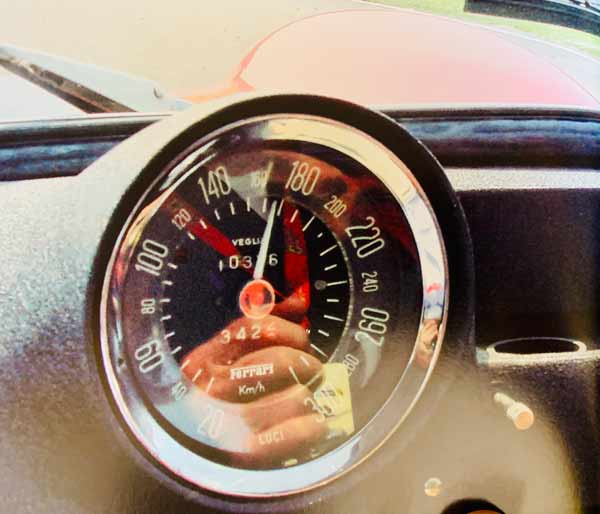A Chronometric Wonderland
Fine instruments are the windows to the soul of classic and vintage cars. Seeing a huge, beautiful Jaeger tachometer with an original matt cream dial face for the first time is almost spiritual. Just thinking about the many stories these fantastic early instruments could tell sends ripples of emotion through me.
 Above: Huge 1930s Alfa Romeo P3 Tipo B Jaeger tachometer. Good for Brooklands, Monza, Le Mans and the Nürburgring
Above: Huge 1930s Alfa Romeo P3 Tipo B Jaeger tachometer. Good for Brooklands, Monza, Le Mans and the Nürburgring
The experience is always unique. No matter if they are branded Veglia, Smiths, Jaeger or VDO, I love every one of these faded, glorious masterpieces. Besides the ‘street’ versions, there are racing versions too, which mostly feature black dials and different calibrations. The Alfa Romeo P3 and some 6C 1750 Grand Sports, the Maserati Tipo 26B and 250F, and of course some Mercedes-Benzes and Bugattis (to name but a few) had them in varying shades of white, off-white and what is probably more accurately described as a silverish-cream colour. Rather uniquely, Maserati chose a bluish hue for the instrument dials in its Birdcage racers as well as the 300 S model (and its derivatives).
 Above: White dials were common in Bugatti racers of the 1920s. These are from a 1921 Bugatti Brescia
Above: White dials were common in Bugatti racers of the 1920s. These are from a 1921 Bugatti Brescia
These early chronometric tachometers, speedometers, oil & water temperature gauges, ammeters, compressor-vacuum gauges, clocks and other gauges were real tools for professionals. They are all rare and exotic finds today, and, when discovered by accident in some long forgotten corner of an old workshop, you can still feel their competitive soul.
 Above: 1950s Ferrari 250 GT gauges, possibly from a Boano-bodied coupe
Above: 1950s Ferrari 250 GT gauges, possibly from a Boano-bodied coupe
Recently, I bought this 1950s-era Ferrari Veglia set that I found in a water-damaged box. I believe they came from a 250 GT Boano or Elena. After 45 years they still work perfectly, so precise and free of play. It is as if time has stood still.
I had the same experience with a complete set of ultra-rare Abarth racing instruments.
 Above: A set of Abarth racing gauges that spent 40 years in a box
Above: A set of Abarth racing gauges that spent 40 years in a box
Only very high-quality instruments could withstand the heat and the wild vibrations of a full-blown racing car of the period. The odd accident, rough handling, damp conditions, even water penetration, don’t seem to do much harm, even in a monoposto. In most cases, they just keep on working.
 Above: A battle-proven and virtually untouched Ferrari 312 T2 cockpit is something else – like a shrine to an era long gone
Above: A battle-proven and virtually untouched Ferrari 312 T2 cockpit is something else – like a shrine to an era long gone
 Above: This must be the most original WO Bentley dashboard ever. The car spent 65 years in a garage. Once started up, all instruments were working properly.
Above: This must be the most original WO Bentley dashboard ever. The car spent 65 years in a garage. Once started up, all instruments were working properly.
When there are problems, it’s nearly always with the fuel gauge. The worst are the red liquid Hobson Petrol Telegauge units used by Rolls-Royce and Bentley in the pre-war era. They are very complicated, finicky to recalibrate and almost never seem to work properly.
There have been literally hundreds of versions of each type of gauge or instrument, specifically calibrated for each type of car. The size of the digits, the shape of the needles, the design and colours of the dial face, as well as the luminous materials and the bezels – all unique to each model.
 Above: Possibly the rarest instrument of all. A Ferrari GTO speedometer. Very few had them at all. Pictured here while sliding around Silverstone at 180km/h. Needless to say I ended up in the gravel…
Above: Possibly the rarest instrument of all. A Ferrari GTO speedometer. Very few had them at all. Pictured here while sliding around Silverstone at 180km/h. Needless to say I ended up in the gravel…
Try to find an original tachometer for a Ferrari GTO, a Mercedes SSK or a Jaguar D-type and you will quickly learn about the many specific and subtle variations in the gauges. A totally scratched and dented but original piece can be worth tens of thousands, whereas a similar piece with only minor differences in calibration can be almost worthless. Jaguar E-type dials are almost everywhere. But you will be hard-pressed to find an original one for a Lightweight!
Taking into consideration all of these different aspects, the early and pre-war instruments are the most beautiful pieces of art. They are today what they always were: robust, durable, reliable and enduring companions to the car they were initially designed for.
 Above: Another ultra-rare gauge – the 1930 Bentley 4 1/2 litre Supercharge Vacuum pressure meter. Try to find one of these!
Above: Another ultra-rare gauge – the 1930 Bentley 4 1/2 litre Supercharge Vacuum pressure meter. Try to find one of these!
 Above: 1928 Bugatti Type 41 Royale Weymann. Possibly the most expensive cockpit in the classic car world. Crocodile leather and a full set of black Jaeger dials behind a huge four-spoke steering wheel.
Above: 1928 Bugatti Type 41 Royale Weymann. Possibly the most expensive cockpit in the classic car world. Crocodile leather and a full set of black Jaeger dials behind a huge four-spoke steering wheel.
To me they are the windows to the soul of a classic and vintage car. But am I the only one out here? Please leave a comment, I’d love to know.
Article by Michael Kliebenstein




Leave a comment
This site is protected by hCaptcha and the hCaptcha Privacy Policy and Terms of Service apply.